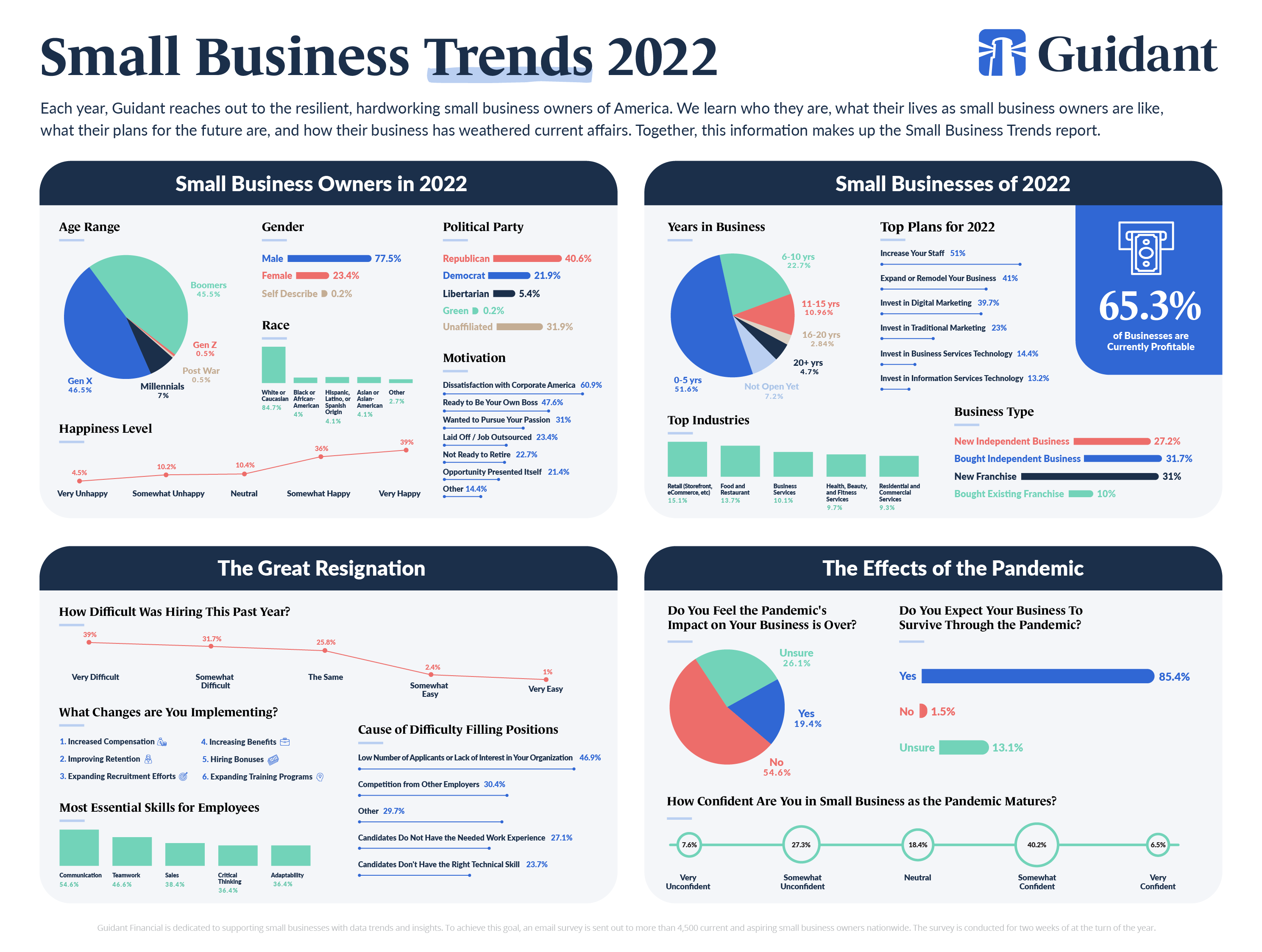2022 Small Business Trends
A look at the state of small business in 2022
Each year, Guidant reaches out to the resilient, hardworking small business owners of America. We learn who they are, what their lives as small business owners are like, what their plans for the future are, and how their business has weathered current affairs. Together, this information makes up the Small Business Trends report.
Here’s a look at current small business trends this year:
Who are Small Business Owners in 2022?
While everyone starts a business for their own reasons, there are a handful of dominant motivations. Business owners primarily went into business because they were ready to be their own boss (60.87%) and overall dissatisfaction with corporate America (47.64%). A large number of business owners were motivated by the opportunity to pursue their passion (31.00%), and a significant number stated they went into business either because an opportunity presented itself (21.36%) or because they were newly unemployed (23.44%). Boredom or financial insecurity post-retirement also appears to be a factor, as more than 20% of respondents reported they started their business because they were “not ready to retire.”
Despite the challenges around recruitment and COVID-19, the overwhelming majority of business owners (74.86%) self-reported as either somewhat happy or very happy. Roughly 15% of business owners reported as somewhat unhappy or very unhappy, leaving the remaining 10% as neutral. On a scale of one to five, with one being “very unhappy” and five being “very happy,” the overall average was 3.95, solidly in happy territory. When compared to happiness scales around the world, this certainly portrays business owners as happier than the average American.


The Generation Gap
Boomers (45.45%) and Gen X (46.46%) made up the two largest generational segments this year. Millennials made up just over 7% of those surveyed, while the oldest and youngest of us — the “Zoomers” of Gen Z and Post War era business owners — made up less than 1%. We expect to see the percentage of Gen X business owners continue to grow in the coming years.
It’s worth noting that the lack of Millennials in our respondents directly contradicts other published data which suggests entrepreneurship amongst Millennials has grown. Whether Millennials are reluctant to classify their ventures as “small business,” the pandemic had a disproportionate effect on Millennial business, or for some other reason, our data do not agree.
Diversity in Business
 Women small business owners took a hit this year in our survey, consistent with trends across America. Women made up only 22.35% of surveyed business owners this year, while men made up the overwhelming majority (77.47%). Less than one percent chose to identify as a gender other than male or female.
Women small business owners took a hit this year in our survey, consistent with trends across America. Women made up only 22.35% of surveyed business owners this year, while men made up the overwhelming majority (77.47%). Less than one percent chose to identify as a gender other than male or female.
Most survey respondents identified as White or Caucasian (84.75%). The next-largest group was a three-way tie between those who identified as “Black or African American,” “Hispanic, Latino, or Spanish Origin,” and “Asian or Asian-American,” all at roughly 4% each. Indigenous Americans made up 1.21% of surveyed business owners. Middle Eastern or North African respondents made up 1.04% of those surveyed, while Native Hawaiian or Pacific Islanders made up less than one percent.
While previous year’s surveys indicated a rise in diversity of small business owners, there is no data to support that trend this year. Whether this is a reflection of the effects of the pandemic or the difference in this year’s sampling methods, we cannot say. Guidant aims to increase the number of people who succeed in small business, especially and including entrepreneurs of color, women in business, and other underserved minorities. We sincerely hope the diversity of these figures will increase in the years to come.




Political Affiliation
Politically, the independent or unaffiliated voter showed up in force. Just about a third of voters (31.87%) stated they didn’t “belong to or feel represented by any political party.” Roughly 41% identified as Republican. Twenty-two percent of respondents identified as Democratic. Less than 6% identified with another party.
What are Small Businesses Like in 2022?
Running a small business is challenging — so challenging that according to the SBA, only half of all small businesses will survive their first five years. Only one-third will make it to ten.
Our survey supports this data. Just over half of respondents (51.61%) had businesses between 0 and 5 years old, and 22.68% had businesses 6 to 10 years old. Eleven percent of business owners reported having businesses 11 to 15 years old, and just under 8% had businesses 16 years old or older. The remaining 7% were in the process of opening their business, but could not yet be considered open.


Independence
The slim majority (58.98%) of businesses were independent, non-franchise businesses. Specifically, 31.76% of respondents started their businesses by purchasing an existing independent turnkey location. This was just slightly more than the business owners who started their independent venture from scratch (27.22%).
Franchisees made up 41.02% of surveyed respondents, and they overwhelmingly favored starting a new franchise location (31.00%) over purchasing an existing franchise location (10.02%).
Industry
Retail (storefront, eCommerce, or other) made up the largest industry category this year at 15.05%. Food and Restaurants were just behind (13.71%) followed shortly by business services (10.10%). The remaining two industries in the top five this year were Health, Beauty, and Fitness services at 9.71% and Residential and Commercial Services at 9.33%. The remaining fourteen categories were all less than 6%.



This year, 65% of business owners reported being profitable at the time of our survey. Given the challenges of the past few years, it’s little surprise that 35% of business owners report that their business is not profitable. Don’t fret too much, though — remember that more than half of businesses surveyed are 5 years old or younger. Given that folk wisdom states businesses usually take two or three years to become profitable, it’s normal for many of them not to have hit that mark yet.
The show must go on, and it’s no different for small business owners. While relatively few are looking to open another location or begin another service (12.10%), equally few are looking to sell their business (10.02%). The majority of business owners are focused on growing their current location (51.80%), and the remaining 26% are focused on sustaining the condition of the business they already have.
The top three priorities business owners reported for 2022 were increasing staff (51.04%), expanding or remodeling their business (41.02%), and investing in digital marketing (39.70%). The second point, expanding or remodeling the business, is especially surprising given the high cost of construction at the moment. It’s possible business owners are going through with their expansions now to lock in low business loan interest rates.
Aspiring business owners will have a leg up if they prioritize these three things — securing reliable staff, investing in digital marketing, and a competitive customer experience at the outset.
Hiring During the Great Resignation


As expected, more than half of respondents reported recruiting and retention of employees as one of their top three challenges — when asked about the difficulty, 70.73% of respondents that tried to hire described recruitment as somewhat or very difficult compared to other years. Behind retention and recruitment, the top three challenges were changing operations in response to COVID-19 (32.14%), lack of capital/cash flow (31.57%), and administrative work (23.25%). A notable minority of business owners commented that they were struggling with the rising cost of goods and supply chain issues, in line with popular reporting.
When asked about the reasons positions were difficult to fill, however, trends emerged. Business owners reported a low number of applicants (46.86%) and competition from other employers (30.43%) as the greatest two challenges, followed by a lack of needed work experience (27.05%) or technical skills (23.67%) in the candidates that DO apply.
The Small Business Response
In response to challenges with retention and recruitment, business owners have overwhelmingly (63.17%) increased compensation. Thirty-three percent are fighting the Great Resignation by making significant efforts to retain current employees. The remaining three strategies in the top five were expanded recruitment advertising efforts (22.93%), increasing benefits (17.80%), and handing out hiring bonuses (16.34%).
Though we surveyed the most difficult positions to fill, no single position type stood out as more or less difficult, implying the effect of the Great Resignation across all skillsets and verticals.




What Skills Do Candidates Lack?
The five most critical employee skills reported by small business owners were communication (54.55%), teamwork (46.56%), sales & customer relationship management (38.36%), critical thinking and problem solving (36.36%), and adaptability.
Unfortunately, more than a third of respondents also reported candidates commonly lacking critical thinking and communication skills. In addition, businesses reported concern that candidates often lack time management skills, adaptability, openness to criticism, and sales and customer relationship management skills.
Is the Pandemic Still Having an Effect on Small Business?


The pandemic’s effects on American lives have left respondents tentative about forming strong opinions. Less than 5% of business owners felt very confident in small business when asked to consider today’s political climate. Eleven percent were very unconfident. The majority were “somewhat” — either somewhat unconfident (31.62%) or somewhat confident (32.30%). The remaining 20% were neutral.
When asked about the future effects of the pandemic, however, most respondents reported feeling somewhat or very confident (46.74%) about the future. Just over 27% of business owners reported feeling somewhat unconfident, and a minority 7.56% of business owners reported feeling very unconfident. Eighteen percent of business owners were neutral. Considering that 54.60% of business owners feel the effects of the pandemic are not yet over, this is a considerable sign of optimism in American small businesses.
And the optimism doesn’t end there: 83.36% of business owners expect their business to survive the COVID-19 pandemic.
The Future of American Small Business
Small business drives 46.8% of private workforce employment and has been the backbone of the COVID recovery. According to our survey, less than a quarter of small businesses furloughed or laid-off employees. Small business is the lifeblood of America.
While it seems clear that the worst of the COVID-19 pandemic and the Great Resignation is behind us, small business has never been easy. If you’re an aspiring small business owner, Guidant can help you get started. If you’re a small business owner ready to make your life easier, now is the time. You didn’t start a small business to get stuck doing administrative work.
Additional Learning Resources
Ready to use your retirement funds to start your business?
No more questions about ROBS? Great! Let’s get the process started today.







